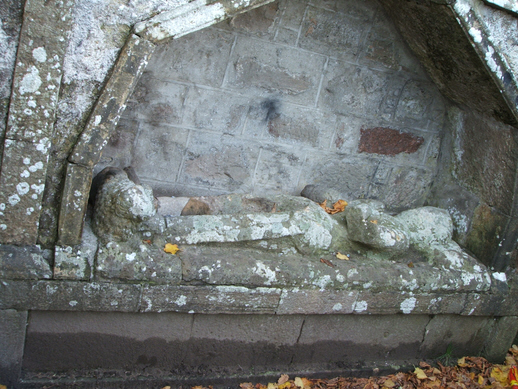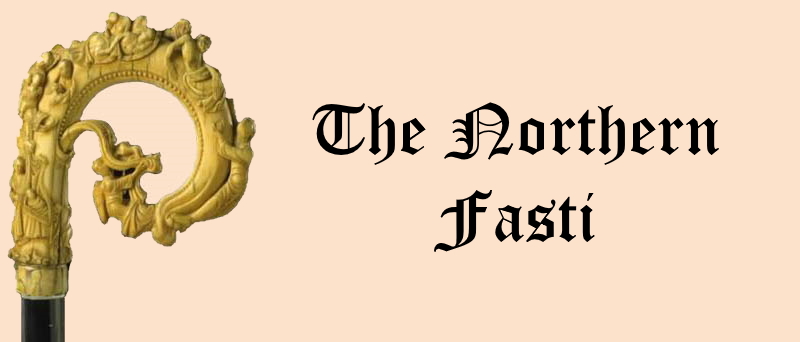Elgin Deanery
Lhanbryde
Parish Church: OS Ref: NGR NJ 271613 H.E.S. No: NJ26SE 10 Dedication: St Bridget.
Associated Chapels: (None known.)
The name of this church is also found as, Lanemalbride, Lamanbride, Llanbryde, Lamnabride, and Longbryde. However, we should be aware that although the second part of the name relates to one of the oldest, and most 'popular', saints in our calendar - Saint Bridget - the first part of the name is a relatively modern invention. In the Lhanbryd Parish Registers, the form "Lhanbride" never occurs until 1783 (after the union with St Andrews parish), the entry being in the hand of Rev William Leslie, the parish minister. This form of the name has remained since that time, although it was many years before outsiders, and even parishioners, came to adopt it. In previous years, the forms most commonly used were Longbride and Lanbride, which remind us of other nearby place-names - Longhill, Longridge, Longmorgan, etc. 1
The entries to be found in the records of Historic Environment Scotland, which relate to the church of Lhanbryde, are somewhat depressing because of their scant details regarding what was a very ancient church indeed. Its dedication to St Bridget is an indicator of this antiquity and we have evidence from the Moray Registrum that there was a church here at least as early as the episopate of Bishop Bricius.2 The charter which records this information is dated to (20 March 1207 x 17 June 1208) so the church of Lamnabride, as it was called in the text, must have been in existence before this. The same charter records that, in addition to the church of Lamnabride, the Precentor's prebend was augmented with a dabhach of land there. It is very possible that this was the dabhach called Petnassere (Pittensair) which lies to the east of the town, near Loch na Bo
Sir Malcolm de Moravia was, at one time, proprietor of the lands of Lambride, which he gave to his son William by a charter executed in 1280, evidently at Elgin. Sir Malcolm was Sheriff of Perthshire and flourished mostly in the time of King Alexander III. He appears to have died before 1286. 4 The terms of the gift to his son were comprehensive and, in return, William was to pay "… one pair of white gloves or one penny … every Pentecost, and one-half knight's service to the king …". Sir Malcolm also willed and granted that his son should pay 3 marks in 'relief'. The witness-list added to this charter is also most interesting because it reveals a number of the individuals who were the 'main players' in the life of the local community at this time. The list included - the Bishop of Moray (Archibald); the Prior of Urquhard (William of Rathen); Gilbert of Glencarnie; John of Pittendreich; Sir Michael, lord Wemyss; William Hay, lord Borthwick; Sir William of Dallas; William Wiseman, Sheriff of Forres; and Eugenius {Ewen}, son of Angus, thane of Rothnoych (Rathenach). This last is of great significance since, in recent times, Rathenach has been considered to be a 'lost barony'. However, it has recently been proposed that it corresponds to Meft, which lies just to the north-west of Lhanbryde
The Register of the Bishopric of Moray shows that one Alexander de Menerys, lord of Lambrid, founded a chaplainry in the year 1350, from the ferms of the land of Mayn(e).5 The foundation was a little unusual since Alexander tells us that it was made at the instance of his friend, John de Inverness, chancellor of the cathedral of Moray, for the benefit of the souls of John, Alexander, and Alexander's mother, Alianore. Nearly fifty years later, the holder of this chaplainry in the cathedral is encountered bearing the name of, "Chaplain of Lanbride and Mayne".6
The Precentor of Moray retained Lhanbryd as a part of his prebend up to the Reformation, but we can see from an entry in the Burgh Court Book of Elgin, dated 23 August 1574, and copied below, that James Thorntoun, the Precentor of Moray at that time, let out some of the lands of Lhanbryd to Innes of Invermarkie. In the face of the Reformation, it would appear that James was taking the opportunity to liquidate some of his assets! James, who is recorded as parsoun of Advie & Cromdale in 1555,7 received a Crown Presentation to the Precentorship of Moray on 25 April 1565.8. The Precentorship was escheated on 8 October 1577 and James is thought to have died before 24 November that year, which leads us to suspect that the prebend was escheated to the Crown upon James' death.
There are no visible remains of the medieval church buildings. The oldest remains are a burial vault - the Coxton Aisle - in the graveyard containing the tomb of Alexander Innes, who died in 1612.9 There is an effigy on top of the tomb showing a knight in full armour and the whole is surrounded by a stone niche. It is thought that the wall that the effigy is set into might be a portion of the old church building.

Crammond recorded that, "… the Knights Templar had land in this parish for, among the Rose Papers [there] was a deed of 1509 on The Temple Lands of Longbride." 11 We also should refer to the records of a case tried in the Court of Session, where there is clear and unarguable evidence of the existence of temple lands in Lhanbryde. 12 The Order of St John of Jerusalem inherited the lands and possessions of the Templar Order on the latter's disolution in 1312, and their records confirm that, in the "Vicecomitatus moravie et Inuerness extra spey", they held 40s land in Lambrid and that these lands had been held previously by the Templars.13 From the evidence produced before the Court of Session, these 'Temple lands' appear as a separate holding, but they were often named along with the Kirktoun of Lhanbryd.
By 1578, the churches of Langbryde and Urquhard were united. The parish of Lhanbryde was then united with that of St Andrews in 1780 and it is said that thereafter, the church of Lhanbryde fell into disrepair. 14 The new parish was known as the Parish of St Andrews-Lhanbryde.
| Name | Including | OS Grid Ref. | Extent | Comment |
|---|---|---|---|---|
| Petnassere | NJ 282607 | 1 dabhach | This is Pittensair. | |
| Pettinseir | 0.5 dabhach | |||
| Easter Pettinseir | 0.5 dabhach | |||
| Information from Ross (2003)10 with locations added by David Moray. | ||||
1207-08 In Bishop Bricius' Magna Carta, which sets out the details of his cathedral establishment at Spynie, the following prebend is allocated to the Precentor: "Secunda canonia Cantarie assignata ecclesia de Lamnabride cum una dauacha terre et ecclesia de Aluays et ecclesia de Rothefd cum omnibus justis earundem pertinentiis." [Moray Reg., no. 46]
1574 (23 August) "Comperit ane honourable man Robert Innes of Innermarky and produceit ane obligatioun maid be him to Master James Thorntoun, chantour {Precentor} of Moray and parsoun of Langbryd quha hes lattin in feufarm and heritage to the said Robert his airis and assignais his town and landis of Kirkhill of Langbryd being ane part of the patrimonye of the said parsonage." 15
1. Crammond, Wm. (1900) The Churches of the Parish of St Andrews-Lhanbryd, Elgin: Courant &Courier, p.94. Return
2. Some time about 1207x1208, Bishop Bricius assigned both the parsonage and vicarage revenues of the churches of Alves, Rafford and Lhanbryde to form the prebend of the Precentor of Moray. In the case of Lhanbryd, the cure seems to have been served by a vicar pensioner. [Moray Reg., no. 46.] https://www.poms.ac.uk/record/source/1702/ Return
3. Moray Reg., Carte Originales, p.459, no.6. Shaw wrote that, "… the Bishop received a davach of land at Pitnasser c.1225 in return for resigning his claims to the Manor of Lhanbride". [Shaw, L. (1882) The History of the Province of Moray, Vol. i, Glasgow: Thomas D. Morison, 326-331, 327.] Return
4. Crammond, Wm. (1900) The Churches of the Parish of St Andrews-Lhanbryd, Elgin: Courant & Courier, p.3.; Moray Reg., Carte Originales, p.461, no.7. Return
5. Moray Reg., no. 228. Return
6. Moray Reg., no. 278. Return
7. Fraser, Wm. (1883) The Chiefs of Grant, Vol. 3, Edinburgh, nos. 302 & 303, p. 379-380. Return
8. Watt, D.E.R. (1969) Fasti Ecclesiae Scoticanae Medii Aev.: ad annum 1638, Edinburgh: Scottish Records Society, 225. Return
9. Alexander Innes was the 1st laird of Coxton. Having recieved a royal warrant in 1572, he built a tower-house on the site of the present Coxton Tower
10. Ross, A. (2003) The Province of Moray, c.1000-1230, unpublished PhD thesis presented to Aberdeen University, Vol 2, 42. Return
11. Crammond, Wm. (1900) The Churches of the Parish of St Andrews-Lhanbryd, Elgin: Courant & Courier, 3. Return
12. Young, Tennent & Fraser (1849) Cases Decided in the Court of Session, Teind Court, and Court of Exchequer: 1848-1849, Second Series, Vol. XI, Edinburgh, 889-905. The Court had before it a "Report of the Parochine of Lhanbryde", completed by the sub-commissioners, stating:
The above extract was part of the Report made following a meeting held by the Sub-Commissioners of the Presbytery of Elgin, on 29 June 1629. They were named as being: Rt. Hon. Robert Lesley of Findrassie; William Innes of Mayne; James Sutherland, Tutor of Duffus; Alexander Innes of Coittis; Mr John Hay, Commissary of Moray; James Spence of Alves, Kirktowne; and Mr John Innes of Cokstain {Coxton}. Mr Gavin Dunbar, Chancellor of Moray, and titular of the teind from these lands, was also present. Return
13. Cowan, Mackay, & Macquarrie (1983) The Knights of St John of Jerusalem in Scotland, Edinburgh: Scottish History Society, 31, 221. The information is drawn from a Rental of 1539-40 which records details of the lands 'inherited' from the Templar Order. Return
14. Mackintosh, H.B. (1924) Pilgrimages in Moray: a guide to the county. Elgin: Walker, 89. Return
15. Crammond, Wm. (1903) The Records of Elgin, 1234-1800, Vol. I., Aberdeen: the New Spalding Club, 146. Return
e-mail: admin@cushnieent.com
© 2021 Cushnie Enterprises

